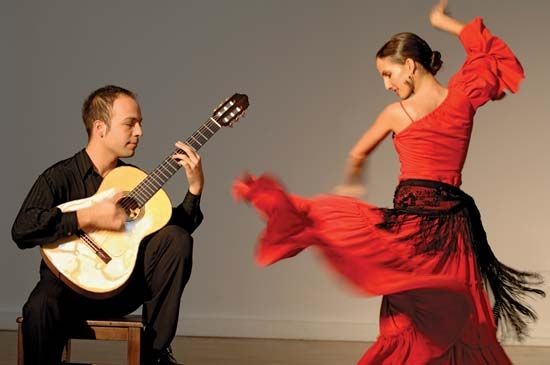(VOVWORLD) - Spain is famous for lots of things including the sexy, wild dancing called flamenco. If you want to learn more about this traditional folk dance of Spain, stick around as we talk to Paco Aibar Barraso, a Barcelona native.
 Flamenco dance is said to have an extensive historical background that parallels the cultural development of Spain itself. (Photo: suspanish.com) Flamenco dance is said to have an extensive historical background that parallels the cultural development of Spain itself. (Photo: suspanish.com) |
Bao Tram: Hello, Paco. Thanks for joining us today. Tell us what makes flamenco special and why the mention of flamenco makes people think of Spain?
Paco: Flamenco is one of the oldest performances in Spain. In general, people from other countries think that Spanish people are very passionate. Flamenco is a music that is interpreted with great passion. Maybe people connect both.
But nowadays, I think flamenco is used as a tourist resource. There are many tourists who visit Spain to experience a flamenco concert or learn how to dance this art.
On the other hand, in many Spanish films flamenco appears as something characteristic of the country, along with the bullfights, the football and the food.
Bao Tram: Well, I’m pretty curious about the origin of flamenco!
Paco: Flamenco has its origins in Andalusia, an autonomous community in southern Spain, and its birth dates back to the 18th century. There is no unanimity on its name, but there is a theory that indicates that flamenco word derives from an Arabic term. It is born from the mixture of many cultures: the Arabic, the Jewish and the gypsies, who arrived in Spain in the 15th century and many stayed in Andalusia.
Bao Tram: The upbeat music makes me wanna dance! How can I do that?
Paco: Normally, in a performance, the “bailaor” or “bailaora” (dancer), especially women wearing a colorful dress, remains immobile during the first moments that the melody sounds. The dancer absorbs the strumming of the guitar, the clapping and the “cante” (singing), until the inspiring beat hits them. The dancer interprets each piece with arm movements, body wiggles and ‘zapateos’ (action of stomping) chords to each flamenco style, accompanied by the melody of the guitar and the deep voice of the singer.
The facial expression is very important in flamenco. The face of the dancer is serious and even furious, perhaps it is the feeling when you get fully into the sound of the claps, the guitar and the songs.
Bao Tram: To my understanding, the hand movements, clapping, and stomping play a crucial role in flamenco. What about the cante you mentioned earlier?
Paco: The “cante” or a sole cry is the way to express pain and passion through this dance. Flamenco dance is a way of expressing human feelings and passions through movements that arise from the dances that this music contains.
Bao Tram: Flamenco has been around for, let’s say, 200 years. So are there any differences between contemporary flamenco and classical flamenco?
Paco: In the eighties, a new generation of artists was born, following the influence of the mythical Camarón de la Isla, Enrique Morente and Paco de Lucía. These artists were more interested in popular urban music.
At the end of the eighties and during the following decade, very different musicians were grouped together under the same style. These were flamenco artists influenced by instrumental music, rock, pop or Cuban music.
Bao Tram: What kind of musical instruments are associated with flamenco?
Paco: As we already know, flamenco combines several elements such as dancing, singing and guitar. But the claps, the finger castanet and the “cajón flamenco” (box-drum flamenco) are also used and are very important.
Bao Tram: Where in Spain can I enjoy the most authentic flamenco performance?
Paco: Andalusia is the cradle and the main focus of flamenco. If you want to hear, breathe and live flamenco, you should go to Cádiz, Seville, Granada, Córdoba or Málaga. But they are by no means the only places where you can listen to good live Flamenco music.
In other cities in Spain there are also a few places to listen and experience good Flamenco. This is because the Andalusians have been an emigrant people, especially within the Spanish state, and many of them have settled in places like Madrid or Barcelona.
Flamenco is performed on the occasion of the celebration of religious festivities, rituals, sacramental ceremonies and private parties.
It is a sign of identity for many groups and communities, especially the gypsies ethnic community, which has played an essential role in its evolution. The transmission of flamenco takes place within dynasties of artists, families, clubs and social groups, which play a decisive role in the preservation and dissemination of this art.
Bao Tram: When the COVID-19 pandemic is over and the world returns to a more normal situation, don’t hesitate to pack your bags to visit Spain and witness an authentic flamenco show. Thank you, Paco, for joining us today and sharing with us some interesting facts about flamenco, a traditional folk dance of Spain.
Paco: If you have the opportunity you should go to Spain and experience a flamenco concert. It is really a fantastic experience. Thanks to you for giving me the opportunity to explain to the listeners about a characteristic cultural trait of my country.
The following video is how a Flamenco performance in one of those cafe cantantes looked like. This clip is incredibly authentic and you get to experience all three aspects of traditional Flamenco.